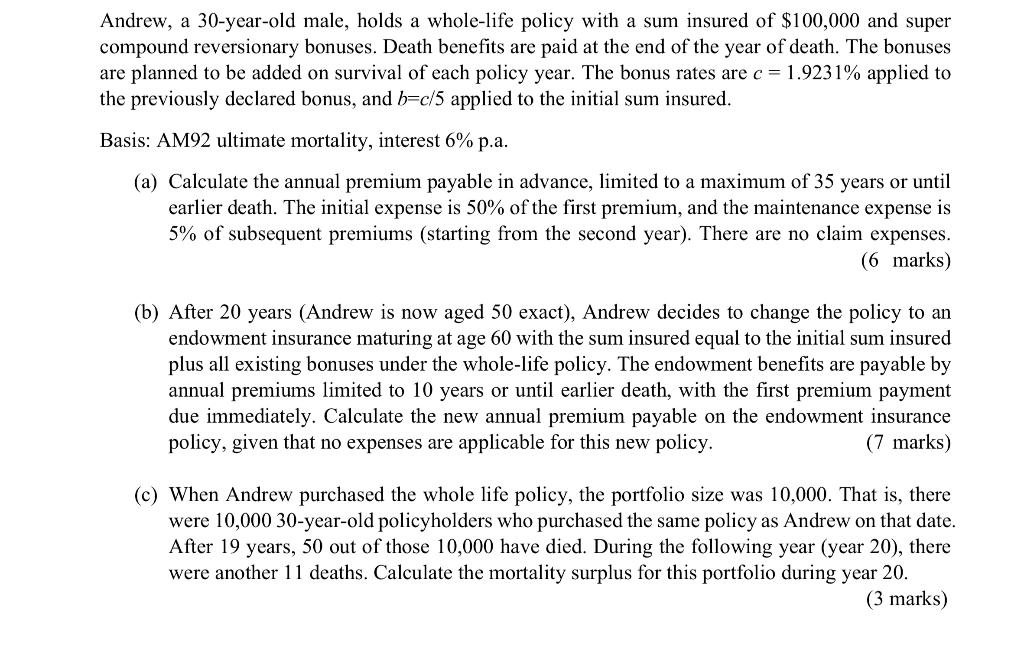
Andrew, a 30-year-old male, holds a whole-life policy with a sum insured of $100,000 and super compound reversionary bonuses. Death benefits are paid at the end of the year of death. The bonuses are planned to be added on survival of each policy year. The bonus rates are c = 1.9231% applied to the previously declared bonus, and b=c/5 applied to the initial sum insured. Basis: AM92 ultimate mortality, interest 6% p.a. (a) Calculate the annual premium payable in advance, limited to a maximum of 35 years or until earlier death. The initial expense is 50% of the first premium, and the maintenance expense is 5% of subsequent premiums (starting from the second year). There are no claim expenses. (6 marks) (b) After 20 years (Andrew is now aged 50 exact), Andrew decides to change the policy to an endowment insurance maturing at age 60 with the sum insured equal to the initial sum insured plus all existing bonuses under the whole-life policy. The endowment benefits are payable by annual premiums limited to 10 years or until earlier death, with the first premium payment due immediately. Calculate the new annual premium payable on the endowment insurance policy, given that no expenses are applicable for this new policy. (7 marks) (c) When Andrew purchased the whole life policy, the portfolio size was 10,000. That is, there were 10,000 30-year-old policyholders who purchased the same policy as Andrew on that date. After 19 years, 50 out of those 10,000 have died. During the following year (year 20), there were another 11 deaths. Calculate the mortality surplus for this portfolio during year 20. (3 marks) Andrew, a 30-year-old male, holds a whole-life policy with a sum insured of $100,000 and super compound reversionary bonuses. Death benefits are paid at the end of the year of death. The bonuses are planned to be added on survival of each policy year. The bonus rates are c = 1.9231% applied to the previously declared bonus, and b=c/5 applied to the initial sum insured. Basis: AM92 ultimate mortality, interest 6% p.a. (a) Calculate the annual premium payable in advance, limited to a maximum of 35 years or until earlier death. The initial expense is 50% of the first premium, and the maintenance expense is 5% of subsequent premiums (starting from the second year). There are no claim expenses. (6 marks) (b) After 20 years (Andrew is now aged 50 exact), Andrew decides to change the policy to an endowment insurance maturing at age 60 with the sum insured equal to the initial sum insured plus all existing bonuses under the whole-life policy. The endowment benefits are payable by annual premiums limited to 10 years or until earlier death, with the first premium payment due immediately. Calculate the new annual premium payable on the endowment insurance policy, given that no expenses are applicable for this new policy. (7 marks) (c) When Andrew purchased the whole life policy, the portfolio size was 10,000. That is, there were 10,000 30-year-old policyholders who purchased the same policy as Andrew on that date. After 19 years, 50 out of those 10,000 have died. During the following year (year 20), there were another 11 deaths. Calculate the mortality surplus for this portfolio during year 20







